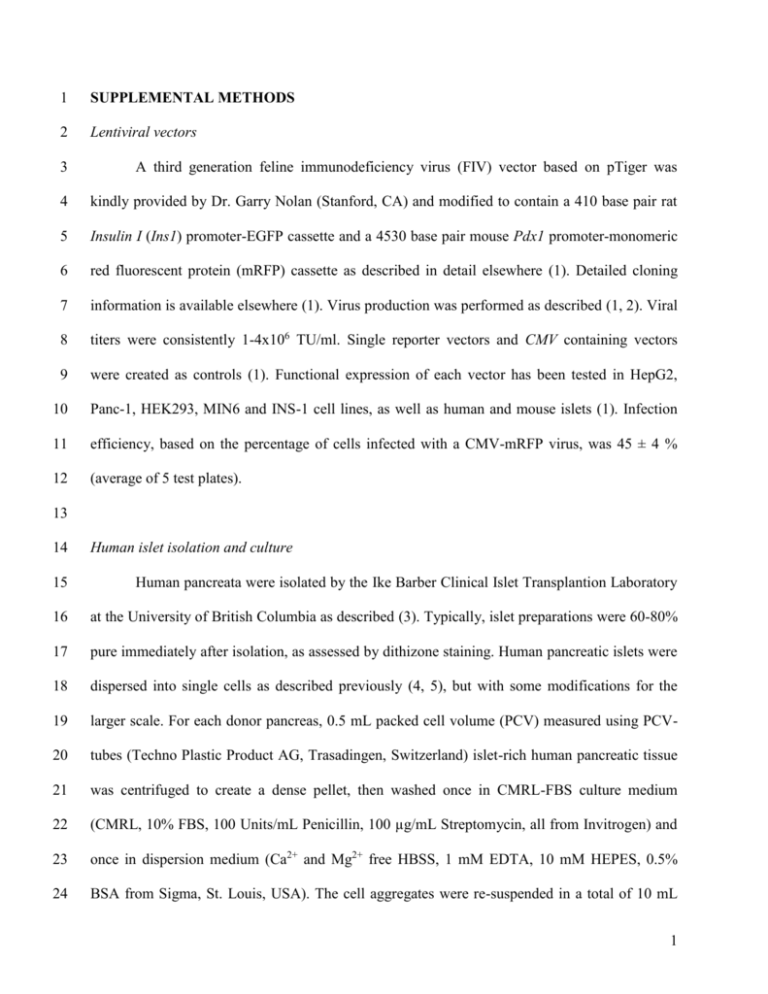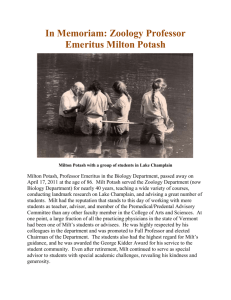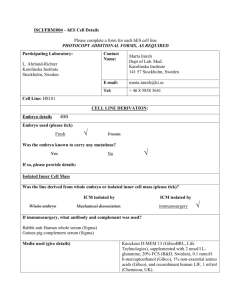In revision for Endocrinology
advertisement

1
SUPPLEMENTAL METHODS
2
Lentiviral vectors
3
A third generation feline immunodeficiency virus (FIV) vector based on pTiger was
4
kindly provided by Dr. Garry Nolan (Stanford, CA) and modified to contain a 410 base pair rat
5
Insulin I (Ins1) promoter-EGFP cassette and a 4530 base pair mouse Pdx1 promoter-monomeric
6
red fluorescent protein (mRFP) cassette as described in detail elsewhere (1). Detailed cloning
7
information is available elsewhere (1). Virus production was performed as described (1, 2). Viral
8
titers were consistently 1-4x106 TU/ml. Single reporter vectors and CMV containing vectors
9
were created as controls (1). Functional expression of each vector has been tested in HepG2,
10
Panc-1, HEK293, MIN6 and INS-1 cell lines, as well as human and mouse islets (1). Infection
11
efficiency, based on the percentage of cells infected with a CMV-mRFP virus, was 45 ± 4 %
12
(average of 5 test plates).
13
14
Human islet isolation and culture
15
Human pancreata were isolated by the Ike Barber Clinical Islet Transplantion Laboratory
16
at the University of British Columbia as described (3). Typically, islet preparations were 60-80%
17
pure immediately after isolation, as assessed by dithizone staining. Human pancreatic islets were
18
dispersed into single cells as described previously (4, 5), but with some modifications for the
19
larger scale. For each donor pancreas, 0.5 mL packed cell volume (PCV) measured using PCV-
20
tubes (Techno Plastic Product AG, Trasadingen, Switzerland) islet-rich human pancreatic tissue
21
was centrifuged to create a dense pellet, then washed once in CMRL-FBS culture medium
22
(CMRL, 10% FBS, 100 Units/mL Penicillin, 100 µg/mL Streptomycin, all from Invitrogen) and
23
once in dispersion medium (Ca2+ and Mg2+ free HBSS, 1 mM EDTA, 10 mM HEPES, 0.5%
24
BSA from Sigma, St. Louis, USA). The cell aggregates were re-suspended in a total of 10 mL
1
25
dispersion medium and transferred to a 25 cm2 suspension T-flask. The cell aggregates were then
26
incubated 7 minutes on a rotary shaker at 75 rpm at 37°C. Trypsin (Roche 109819) and DNase I
27
(Sigma D5025) were added respectively to concentrations of 25 µg/mL and 4 µg/mL (8 Kunitz
28
units/mL). After 10 minutes of digestion, mostly single cells and some clusters of cells were
29
obtained and 20 mL CMRL-FBS were then added. The dispersed cell mixture was triturated 10-
30
20 times and then passed through a 40 µm nylon mesh to remove remaining aggregates. Large
31
aggregates of DNA and cell debris were discarded prior to sieving. The cell suspension (~120
32
million live cells, 70-80% viability) was centrifuged at 250 g for 7 minutes and seeded in
33
CMRL-FBS at 40 000 cells/well in 96-well Viewplates (PerkinElmer) using a multichannel
34
pipette. After 24 hours (day 1), all cells in sample wells for screening were infected with the dual
35
reporter pTiger vector at an MOI of ~1.5. Some control wells pinned with DMSO were infected
36
with the control CMV-eGFP or CMV-mRFP control pTiger vectors instead to assess infection
37
efficiency. Non-adherent cells and the CMRL-FBS medium were carefully removed using a
38
multichannel pipette. The concentrated virus stock was diluted in CMRL-SFM culture medium
39
containing: phenol red-free CMRL (Cellgro), 0.2% bovine serum albumin (Stem Cell
40
Technologies), 10 mM nicotinamide (Stem Cell Technologies), insulin (0.5 mg/L)/transferrin
41
(0.5 mg/L)/selenium (5µg/L) (Sigma I1884, used at 1/10th concentration), 100 Units/mL
42
Penicillin and 100 µg/mL Streptomycin. An aliquot (100 L) of this media was added to each
43
well, followed by virus infection. On day 2, the virus-containing medium was replaced by 100
44
L/well of fresh CMRL-SFM. Another medium exchange of 200 L/well of fresh CMRL-SFM
45
was performed on day 3 immediately prior to extract pinning.
46
47
MIN6 cell culture
2
48
MIN6 beta-cells stably expressing the lentiviral dual-reporter virus were cultured in
49
DMEM media containing 25 mM glucose, phenol red, 10% fetal bovine serum, pencillin, and
50
streptomycin (Invitrogen). Cells were plated at a density of ~6000-8000 cells per well in 96-well
51
polystyrene plates (6)(ViewPlate, PerkinElmer). After a 24-hour incubation period, 100 l
52
DMEM was added to each well using a multi-well pipet to compensate for any media that had
53
evaporated during the incubation period and reduce row and column effects prior to the addition
54
of extracts. Cells were incubated at 37C in CO2 controlled conditions unless otherwise noted.
55
56
Extract library
57
We screened stable dual reporter-expressing MIN6 cells and the human endocrine tissue
58
fraction in the presence of a library of extracts derived from marine invertebrates, primarily sea
59
sponges. Dried extracts were re-suspended in DMSO in 96-well plates and stored at -20C.
60
Details of this natural extract library have been published elsewhere (7). After a 24-hour
61
incubation period, 100 l DMEM was added to each well using a multi-well pipette to
62
compensate for any media that had evaporated during the incubation period and reduce row and
63
column effects. Immediately prior to pinning, extracts were thawed, covered in tin foil to
64
minimize exposure to light and shaken for ~5 minutes at 550 rpm on an Orbital plate shaker.
65
Extracts were transferred to plates by a pinning robot using 0.4 mm pins, transferring
66
approximately 200 nl. After the addition of extracts, cells were incubated for 24 hours in the case
67
of MIN6 cells or for 4 days (until day 7) in the case of human islets (Fig. S1).
68
69
Image acquisition and object identification
3
70
Prior to imaging, the high-glucose media were removed from cells and replaced with 100
71
l per well 1x PBS and 2% FBS with 1:10000 Hoechst nuclear dye. Images were acquired by
72
automated fluorescence microscopy using the Cellomics ArrayScan VTI (Thermo Fisher). Images
73
from each well were acquired in three separate fluorescent channels (for Hoechst, GFP and
74
RFP), using a 10x objective. Object (cell) identification was performed using the Cellomics
75
Target Activation algorithm, with background correction set to 10 pixels and with an isodata
76
(peak-based) intensity threshold adjusted by -0.99 to refine object selection. Individual object
77
resolution was aided by performing object segmentation based on indentations of objects.
78
Human tissue samples have a greater tendency to aggregate when compared with MIN6 cells, so
79
object segmentation was set to a greater value. Parameter values were optimized after testing a
80
variety of combinations of values. Ultimately, the values selected minimized excluding objects
81
with a trade-off in the inclusion of some cell aggregates for the exclusion of some single cells
82
(Fig. S2). For each cell/object identified, average and total intensity and intensity variance
83
measurements were taken.
84
85
Image acquisition and object identification
86
Images were acquired by automated fluorescence microscopy using the Cellomics
87
ArrayScan VTI (Thermo Fisher). Object (cell) identification was performed using the Cellomics
88
Target Activation algorithm. For each cell/object identified, average and total intensity and
89
intensity variance measurements were taken. Additional details are presented in the Supplement.
90
91
B-Score Data Transformation
4
92
93
Data were transformed to mitigate systematic row and column effects using the B-score
method. It is calculated as follows:
Bscore
94
rijp
1.4826 * MAD p
95
The denominator term MADp refers to the median absolute deviation of plate p and is calculated
96
by:
97
MADp median(| rijp median(rijp ) |)
98
where rijp refers to the residual value of well (i,j) on plate p. Residuals are obtained by
99
performing a two-way median polish on the data. This is an additive model that fits a common
100 term per well and row and column effects plus any residual value (8). The median polish was
101
calculated by finding and removing row and column medians in an alternating fashion until the
102
sum of the absolute values of the residuals is less than a small value, here 10-5, or until a
103
maximum number of iterations has occurred, here 200 (9). The residuals are expected to centre at
104
zero, thus the magnitude of the median of the absolute values of the differences between each
105
residual and the median residual value (i.e. MADp) estimates the spread of the data. The residual
106
is defined as follows:
^
^
^
^
107
rijp y ijp y ijp y ijp ( p R ip C jp )
108
where yijp is the observed value in well (i, j) of plate p, and y ijp is the fitted value of that well,
^
^
^
109
defined as the sum of the plate mean ( p ), the row bias of row i ( R ip ) on plate p and the column
110
111
bias of column j ( C jp ) on plate p. If data are normally distributed, MADp can be made
comparable to a standard deviation by multiplying by a scale factor, 1.4826 (10). Median and
112
values for each well were subjected to B score normalization. All B scores were
99th quantile
^
5
113
calculated using the package cellHTS (9) for R or, subsequently, using code we have designed
114
for R written by J. Hill.
115
116
Compound Purification
117
A specimen of the freeze-dried sea cucumber (161 g) collected in Pohnpei was extracted
118
exhaustively with MeOH (3 x 100 mL) at RT. After evaporation the crude extract was
119
partitioned between H2O (1x15 mL) and EtOAc (4x5 mL) followed by n-BuOH (4x5 mL). The
120
combined dried active n-BuOH extract was then fractionated by Sephadex LH20 column
121
chromatography to give an active fraction consisting of bivittoside D.
122
123
Gene expression analysis
124
MIN6 cells (passages 25-39) were maintained in high glucose DMEM (Invitrogen,
125
Carlsbad, CA, USA) supplemented with 10 % FBS (Invitrogen, Carlsbad, CA, USA) and 1%
126
penicillin/streptomycin (Invitrogen, CA). MIN6 cells were plated at 50-70% confluency in tissue
127
culture treated 12 well plates, (NUNC, VWR, Mississauga, ON, Canada) and treated for 18-24
128
hours with 2 µl/ml of serially diluted (1x10-1, 1x10-2, 1x10-3) crude and butanol extracts in
129
DMEM media. Total RNA was isolated by Trizol method (Invitrogen, Carlsbad, CA, USA)
130
followed by RNA purification, using RNeasy kit, Qiagen (Mississauga, ON, Canada). DNase-
131
treated total RNA (100ng) was converted to cDNA by qScript cDNA synthesis kit, (Quanta
132
BioSciences, Inc., VWR, Mississauga, ON, Canada). Real-time PCR was performed on Applied
133
Biosystems StepOnePlus™ platform. TaqMan custom design primers for Ins1 and Ins2 and
134
cyclophilin N008907.1.pt were purchased from Integrated DNA Technologies (IDT, Coralville,
135
IA). Sequences for primers and probes for Ins1 and Ins2 were provided by Dr. Jake Kushner (U
136
Penn). Ins1 5’- GAA GTG GAG GAC CCA CAA GTG, probe /56-FAM/CCC GGG GCT TCC
6
137
TCC CAG CT/3IABlk_FQ/, 3’ - ATC CAC AAT GCC ACG CTT CT, Ins2 5’ GAA GTG GAG
138
GAC CCA CAA GTG probe /56-FAM/CCT GCT CCC GGG CCT CCA /3IABlk_FQ/, 3’ GAT
139
CTA CAA TGC CAC GCT TCT G. Pdx-1 primers in SYBR green assay were: 5’ GCT CAC
140
GCG TGG AAA GGC CAG T, 3’ AGC TGG CAG TGA TGT TGA ACT TGA CCG AGA G,
141
β-actin primers 5’ TGC GTG ACA TCA AAG AGA AG, 3’ GAT GCC ACA GGA TTC CAT
142
A. The relative changes in gene expression were analyzed by the 2-∆∆Ct method and statistics by
143
one-way ANOVA (n=4-5, biological replicates).
144
145
Insulin secretion
146
MIN6 cells were treated with compounds, as indicated, for 18-24 hours in 25 mM
147
glucose containing DMEM media supplemented with 10% FBS. Media were collected and
148
centrifuged at 5000g for 5 minutes to remove any cellular debris and insulin levels were assayed
149
with a rat insulin radioimmunoassay kit (Linco Research, St Charles, MO, USA).
150
151
Statistics
152
The R environment for statistical computing (http://www.R-project.org) was used for
153
data analysis during the screening process, unless otherwise indicated. In all cases, unless
154
otherwise mentioned, five replicate experiments were performed and statistical tests were
155
considered significant at an alpha level of 0.05. For follow-up studies, Graphpad Prism or
156
Microsoft Excel were used to perform ANOVA or t-tests as appropriate. Results were considered
157
significant if the P value was less than 0.05.
158
159
160
7
161
REFERENCES
162
163
164
165
166
167
168
169
170
171
172
173
174
175
176
177
178
179
180
181
182
183
184
185
186
187
188
189
190
191
1.
2.
3.
4.
5.
6.
7.
8.
9.
10.
Szabat M, Luciani DS, Piret JM, Johnson JD 2008 Maturation of Adult Beta-Cells
Revealed Using a Pdx1/Insulin Dual Reporter Lentivirus. Endocrinology
Curran MA, Nolan GP 2002 Recombinant feline immunodeficiency virus vectors.
Preparation and use. Methods Mol Med 69:335-350
Warnock GL, Meloche RM, Thompson D, Shapiro RJ, Fung M, Ao Z, Ho S, He Z,
Dai LJ, Young L, Blackburn L, Kozak S, Kim PT, Al-Adra D, Johnson JD, Liao
YH, Elliott T, Verchere CB 2005 Improved human pancreatic islet isolation for a
prospective cohort study of islet transplantation vs best medical therapy in type 1 diabetes
mellitus. Arch Surg 140:735-744
Johnson JD, Misler S 2002 Nicotinic acid-adenine dinucleotide phosphate-sensitive
calcium stores initiate insulin signaling in human beta cells. Proc Natl Acad Sci U S A
99:14566-14571
Luciani DS, Johnson JD 2005 Acute effects of insulin on beta-cells from transplantable
human islets. Mol Cell Endocrinol 241:88-98
Luciani DS, Gwiazda K, Yang TL, Kalynyak TB, Bychkivska Y, Frey MH, Jeffrey
KD, Sampaio AV, Underhill TM, Johnson JD 2008 Roles of IP3R and RyR Ca2+
Channels in Endoplasmic Reticulum Stress and {beta}-Cell Death. Diabetes
Tarling CA, Woods K, Zhang R, Brastianos HC, Brayer GD, Andersen RJ, Withers
SG 2008 The search for novel human pancreatic alpha-amylase inhibitors: highthroughput screening of terrestrial and marine natural product extracts. Chembiochem
9:433-438
Tukey JW 1977 Exploratory data analysis. Reading, Mass. ; Don Mills, Ont.: AddisonWesley Pub. Co.
Boutros M, Bras LP, Huber W 2006 Analysis of cell-based RNAi screens. Genome
Biol 7:R66
Hoaglin DC, Mosteller F, Tukey JW 1983 Understanding robust and exploratory data
analysis. New York: Wiley
8









